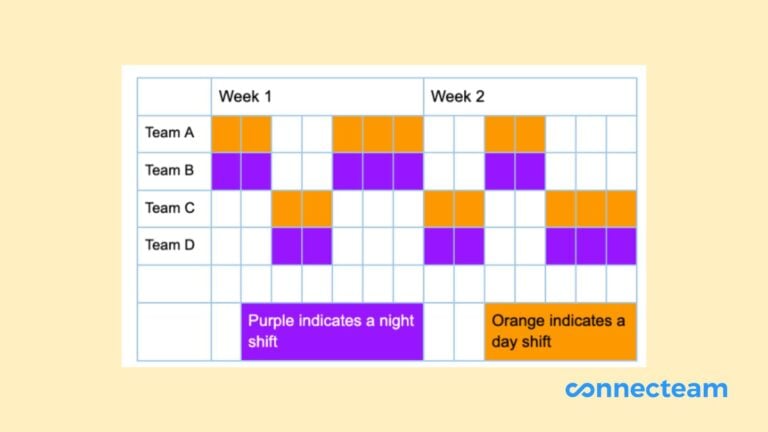The Pitman Schedule is a 14-day shift rotation for 24/7 operations. This guide covers its pros, drawbacks, implementation, and legal considerations.
If your business never sleeps, finding the right schedule is crucial to getting 24/7 coverage without wearing out your team or hurting your efficiency.
The Pitman schedule is one option for covering all hours while ensuring your staff stays healthy and engaged.
Let’s explore how the Pitman schedule works, its pros and cons, and implementation strategies.
What Is a Pitman Schedule? An Overview
The Pitman schedule is a shift system designed for organizations that need around-the-clock coverage. It operates on a 14-day cycle involving 4 teams working 12-hour shifts. Shifts include both days and night shifts, followed by a set number of rest days.
For example:
- Team A might work 2 day shifts, take 2 days off, work 3 day shifts, then rest for 2 days (2-3-2).
- Team B follows a similar night pattern to ensure all hours are covered.
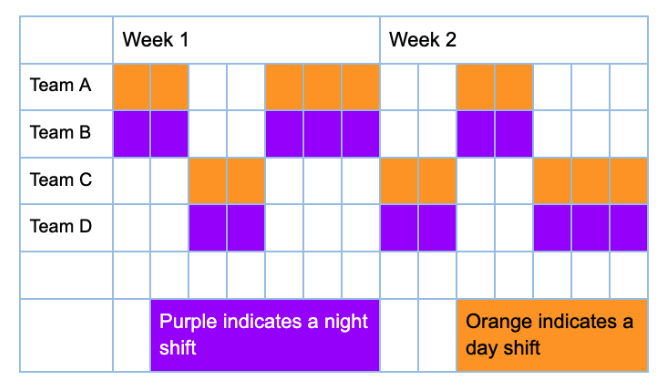
This work schedule is particularly notable for its fixed or rotating shift patterns, where teams either stick to day or night shifts or alternate between them—depending on the variant implemented. This system balances intensive work periods with adequate rest to maintain employee efficiency and well-being.
Understanding the Pitman Shift Schedule Types
The Pitman work schedule has 2 variants.
Variant 1: The Pitman fixed schedule
In the fixed variant of the Pitman schedule:
- Teams follow a 2-week timetable.
- Teams are permanently fixed to either day or night shifts.
- For example, Team A always works days, while Team B always works the night shifts.
This consistency helps employees maintain regular sleeping patterns, which can benefit their health and well-being.
Fixed Pitman schedule 14-day overview: Teams A and B
Teams A and B have a mirrored pattern of work and rest days, with Team A working days and Team B working nights.
| Team A (Day) | Team B (Night) |
| Work 2 days | Work 2 nights |
| 2 OFF | 2 OFF |
| Work 3 days | Work 3 nights |
| 2 OFF | 2 OFF |
| Work 2 days | Work 2 nights |
| 3 OFF | 3 OFF |
Fixed Pitman schedule 14-day overview: Teams C and D
Teams C and D start their cycle with 2 days off and follow the same pattern as Teams A and B, offset by 2 days.
| Team C (Day) | Team D (Night) |
| 2 OFF | 2 OFF |
| Work 2 days | Work 2 nights |
| 3 OFF | 3 OFF |
| Work 2 days | Work 2 nights |
| 2 OFF | 2 OFF |
| Work 3 days | Work 3 nights |
Pitman fixed schedule week 1 overview (all teams)
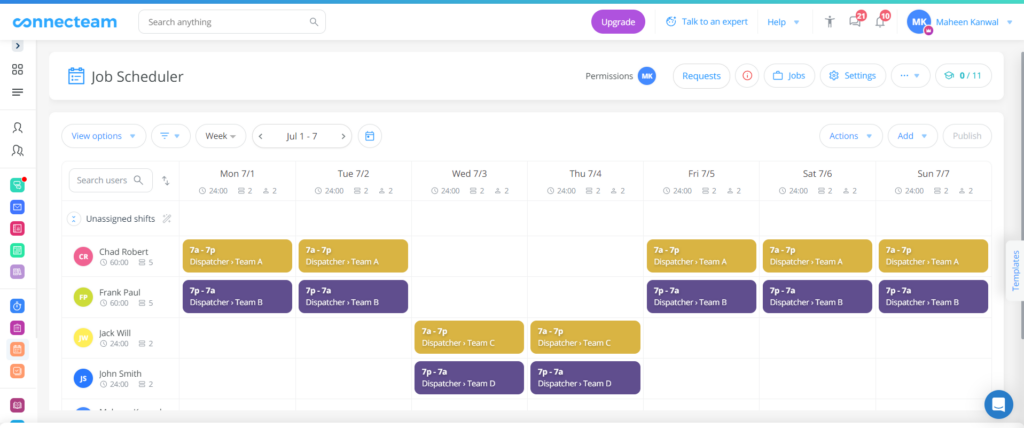
Pitman fixed schedule week 2 overview (all teams)
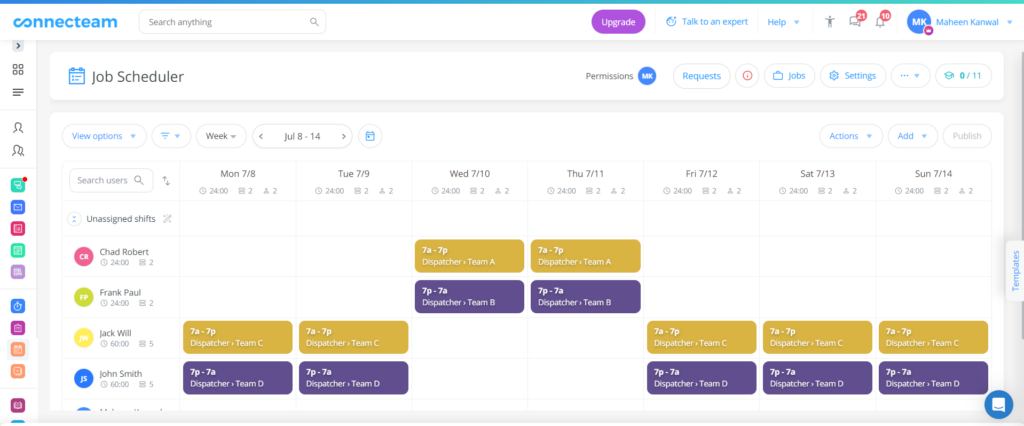
Pitman fixed schedule 14-day overview (all teams)
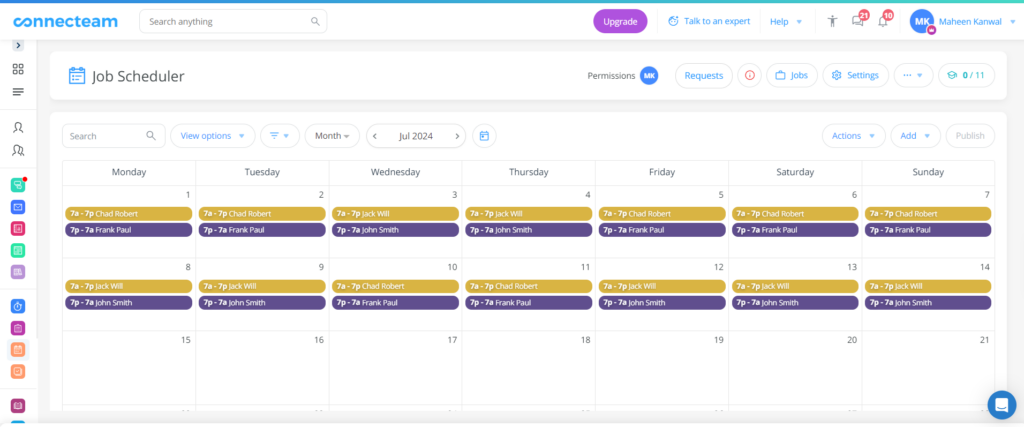
Variant 2: The rotating Pitman schedule
The rotating schedule allows for a fairer distribution of day and night shifts among all teams. Teams alternate between day and night shifts for 2 weeks at a time within a 28-day cycle. The pattern for each team is often summarized as 2-2 3-2 2-3, reflecting the following work-rest pattern:
- Weeks 1 and 2 (day shift/night shift):
- Work 2 days, 2 days off
- Work 3 days, 2 days off
- Work 2 days, 3 days off
- Weeks 3 and 4 (night shift/day shift):
- Same as weeks 1 and 2
For example:
- Team A works days during weeks 1 and 2 and nights during weeks 3 and 4.
- Team B mirrors Team A but starts with nights during weeks 1 and 2 and switches to days during weeks 3 and 4.
- Teams C and D cover the opposite shifts of Teams A and B, respectively.
This approach is designed to distribute the burden of night shifts more evenly among the staff and can be fairer in terms of workload.
| Team A | Team B | Team C | Team D |
| 2 days | 2 nights | 2 OFF | 2 OFF |
| 2 OFF | 2 OFF | 2 days | 2 nights |
| 3 days | 3 nights | 3 OFF | 3 OFF |
| 2 OFF | 2 OFF | 3 days | 3 nights |
| 2 days | 2 nights | 2 OFF | 2 OFF |
| 3 OFF | 3 OFF | 2 days | 2 nights |
| 2 nights | 2 days | 2 OFF | 2 OFF |
| 2 OFF | 2 OFF | 2 nights | 2 days |
| 3 nights | 3 days | 3 OFF | 3 OFF |
| 2 OFF | 2 OFF | 3 nights | 3 days |
| 2 nights | 2 days | 2 OFF | 2 OFF |
| 3 OFF | 3 OFF | 2 nights | 2 days |
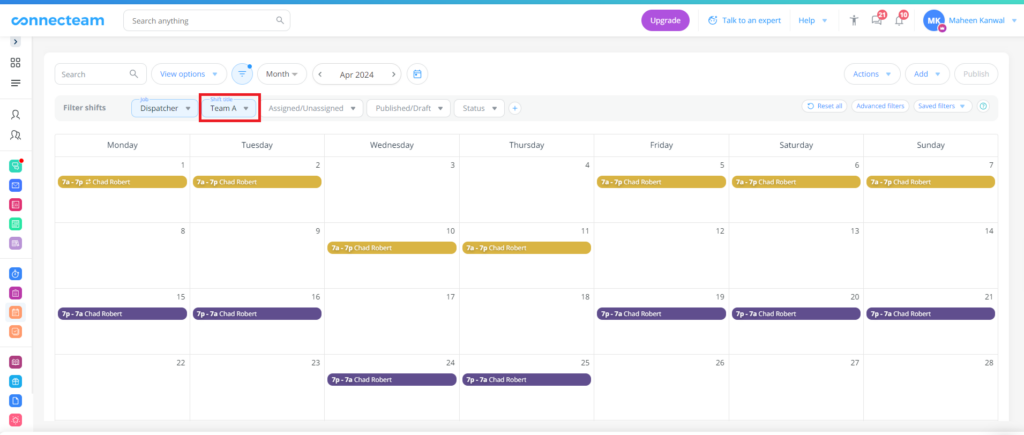
Who Uses the Pitman Schedule?
The Pitman shift schedule is favored in industries that require constant activity and coverage. Companies benefit from its structured yet flexible approach to shift management. Here are some sectors that use this schedule:
- Healthcare.
- Law enforcement and public safety.
- Transportation and logistics.
- Manufacturing and production.
- Utilities and energy.
- Hospitality and services.
5 Benefits of the Pitman Schedule
The Pitman work schedule offers several advantages, making it attractive for industries requiring 24/7 coverage. Let’s discuss its pros.
Can enhance work-life balance with regularly scheduled off days
Some employees find that the Pitman Schedule enhances their work-life balance due to the time off.
They work 2 or 3 consecutive days followed by 2 or 3 days off, offering more frequent rest periods. This can offer them predictable time off to spend with family or pursue personal interests.
One Pitman worker revealed, “12’s with a pitman schedule are my favorite shift schedule by far. 2 on, 2 off, 3 on, 2 off, 2 on, 3 off. I get half of the calendar year off, I can take a 7-day vacation from work and use 2 shifts worth of leave, and I get a three day weekend twice a month. Having days off during the week every week makes appointments and personal stuff super easy.”
Reduces worker fatigue with well-spaced shifts
With blocks of days off following work periods, the schedule can provide ample time for employees to rest and recuperate. This setup helps reduce the physical and mental fatigue commonly associated with shift work and promotes a more consistent sleep schedule. These factors lead to more alert and effective employees during their working shifts.
Another Pitman employee said, “I like it a lot, I feel like it is always a weekend and I can keep a consistent sleep and life schedule. I also really like having so many weekend days off and I also have days off during the week to get [stuff] done that I can’t cause of night shift.”
Provides fair distribution of shifts
In the rotating variant, the Pitman schedule offers a fair rotation between day and night shifts, preventing any single group from shouldering the burden of less desirable night shifts consistently.
Alternatively, for some employees, the option to have just day or night shifts can be beneficial. For instance, single parents might prefer just day or night shifts but not both, as this allows them to maintain a regular routine that aligns better with childcare needs.
Ensures uninterrupted coverage for essential services
The Pitman schedule ensures consistent staffing levels, so with careful planning, there should always be enough employees on duty to maintain continuous operations.
Simplifies the scheduling process with repeatable pattern
Once implemented, the Pitman schedule is straightforward to manage, especially with modern shift scheduling software. It offers a repeatable pattern that simplifies long-term planning and reduces scheduling errors.
6 Cons of the Pitman Schedule
While the Pitman Schedule has many benefits, there are also several challenges that organizations must consider:
- Difficult implementation: The schedule’s structure is complex, requiring careful planning and specialized software to get the schedule off the ground.
- Potential for increased fatigue: The schedule’s reliance on 12-hour shifts, especially night shifts or physically demanding work, can heighten fatigue—impacting employees’ health and productivity.
- Rigidity: It offers consistency but lacks flexibility, limiting employees’ ability to swap shifts or adjust schedules to accommodate personal needs.
- Employee dissatisfaction: The fixed schedule, especially with its long night shifts, can be challenging for some—potentially lowering morale and increasing turnover rates.
- Challenges in work-life balance: Despite employees having several days off, the long consecutive work days can still restrict personal time—affecting work-life balance and overall employee satisfaction.
One Pitman employee wrote, “It’s one of those things that you eventually just kind of get used to, but that kind of messed up sleep schedule is not normal by any means, and some people have a harder time living like that as the body just can’t adapt to it.”
Operational Implementation of the Pitman Schedule
Implementing the Pitman schedule requires careful planning and consideration to meet organizational needs and support employee welfare. Here’s how to effectively put this schedule into practice:
- Ensure adequate staff levels to cover all shifts, factoring in potential absences for illness or vacation. Consider using on-call employees or temporary workers to fill gaps and ensure continuous coverage.
- Assess employee preferences for day or night shifts (or both) and the acceptability of 12-hour shifts to decide between fixed or rotating schedules. You can use surveys or gather 1-on-1 feedback.
Pro Tip
Shift work is associated with increased car accidents, and shift workers are advised against driving drowsy and encouraged to use alternative transportation. Consider providing or organizing transportation for employees, especially those working night or early morning shifts.
- Determine if 24/7 coverage is essential for your operations and if the Pitman schedule is the most efficient approach.
- Review local labor laws related to shift work and alternative work schedules, focusing on compliance with overtime regulations, mandatory rest periods, and more.
- Inform and educate the staff about the Pitman schedule, including its shift patterns and the reasoning behind its implementation. Use employee training software so they can learn at their own pace.
- Trial the schedule to identify any issues and allow for adjustments, asking for employee feedback.
- Modify the schedule based on trial feedback to suit employee needs and operational efficiency better.
- Implement shift scheduling software like Connecteam, which supports complex patterns and offers easy shift management and update features.
Use communication tools like Slack to streamline schedule updates and coordinate teams.
Did You Know?
While many scheduling tools require additional software for effective communication, Connecteam offers a built-in team chat app feature.

Comparing 24/7 Shift Schedules
Here’s a comparison of 3 popular 24/7 schedules: the Pitman, DuPont, and Panama (2-2-3) work schedules.
| Pitman Schedule | DuPont Schedule | Panama (2-2-3) Schedule | |
| Cycle Length | 14 days | 28 days | 28 days |
| Teams | 4 teams | 4 teams | 4 teams |
| Shift Length | 12 hours | 12 hours | 12 hours |
| Work Pattern | 2 on, 2 off, 3 on, 2 off, 2 on, 3 off | 4 on, 3 off, 3 on, 1 off, 3 on, 3 off | 2 on, 2 off, 3 on, 2 off, 2 on, 3 off |
| Day/Night Shift Rotation | Fixed or rotating | Rotating | Rotating |
| Degree of predictability | High, with regular off weekends | Moderate, with varied off days | Moderate, with no more than 3 consecutive workdays |
Legal Considerations for the Pitman Schedule
To implement the Pitman schedule, you must consider following factors:
Overtime laws and regulations
Non-exempt employees working these long shifts will sometimes exceed standard 40-hour workweeks, depending on the frequency of their shifts within the cycle. For example, Team A working 5 shifts—or 60 hours—in the first week leads to overtime of 20 hours. These employees must be paid overtime rates in accordance with overtime laws.
One Pitman worker mentioned, “Recently, our management discovered that we are not exempt from FLSA overtime rules as we previously thought. This means that any hours we work over 40 in a 7 day period are required to be paid as overtime. With the Pitman schedule, one week is 36 hours and the other week in the pay period is 48 hours. So, according to federal law, they are required to pay us 8 hours of overtime every other week.”
Pro Tip
Implement scheduling and overtime management software like Connecteam, which accurately tracks hours worked and automatically calculates overtime rates in accordance with state laws.
Other laws and regulations
There are various other laws and regulations you might need to consider when implementing a Pitman schedule.
For instance, one California regulation requires a secret ballot election where at least 2/3 of affected employees must approve alternative work schedules—including the Pitman schedule.
Here are some other laws and regulations you might want to consider:
- Meal and rest break laws
- Laws concerning minimum rest periods between shifts
- Industry-specific regulations
Pro Tip
The best way to ensure compliance when implementing a 24/7 schedule is to consult with a labor lawyer. They can let you know which laws and regulations apply to your business.
Cumulative fatigue
Continuous 12-hour shifts can lead to cumulative fatigue, potentially increasing the risk of errors and accidents. These can lead to indirect costs, such as higher insurance premiums or legal liabilities.
Pro Tip
Help your workers combat fatigue. Start by checking out the Occupational Safety and Health Administration’s page on worker fatigue prevention, which includes guidelines for employers and employees, information on fatigue risk management programs, and resources. You might consider making your own fatigue management training program.
Enhance Pitman Schedule Efficiency With Connecteam
The Pitman Schedule, with its structured 14-day cycle, offers a practical solution for industries requiring continuous operations.
It offers different variants to cater to specific needs, providing stability or fair shift distribution. However, the system can be complex and may lead to overtime challenges, and there are risks of employee fatigue and worse. This is why you must be careful implementing this schedule and other 24/7 shift schedules.
Connecteam is an AI scheduling software that can help you properly implement whichever 24/7 schedule you choose. It simplifies complex scheduling, tracks overtime and breaks, improves communication, and so much more.


